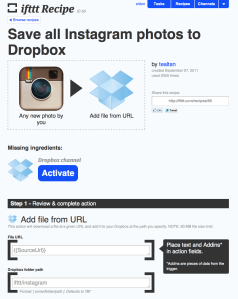Want to instantly save all your Instagram photos to Dropbox when you take them? What about automatically updating your Twitter profile when you update your Facebook profile? Or, what about sharing any article you read in Read It Later to Twitter and Facebook, staggered by time via Buffer? A small bootstrapped startup called If This Then That has abstracted a simple set of tools to help you do each of these things, and many more.
And now it’s raised a big seed round of more than $1.5 million from some of the top angels and venture capitalists in tech.
We’ve talked about how IFTTT works a couple times already on TechCrunch, but here’s a quick review. The idea is that you choose from any of the enabled services, or “channels” in IFTTT’s terminology, then you choose a “trigger” action, and a resulting “action.” Or as the name suggests, If This [Trigger] Then That [Action]. The resulting set of actions is called “recipe,” which you can also share and borrow with other users on the site (follow the links at the top of the article for more details on the examples I listed).

Right now, the focus is on helping users easily share information between any two services, with phone calls and major sites like YouTuBe and Facebook on the list as well as startups like Diigo and ffffound. The reason the site has been getting traction is that anyone can pretty easily use it for a specific task they need done, that no particular web service is going to build for them. While founder Linden Tibbets isn’t disclosing more specific numbers, he says that over 500,000 tasks have been created to date, contained in some 14,000 recipes, with 90 million tasks being triggered so far, at the current rate of 1 million per day.
As more and more web users become more sophisticated at using multiple sites for specific tasks, IFTTT is positioned to be the glue that binds them together. In and of itself, that’s a promising vision.
But as Tibbets tells me, there’s an even bigger idea here, which is plugging the service into the so-called “internet of things” — meaning, connecting the web to physical devices to get more value out of them. A simple example of this, he says, could be outfitting your dog with a GPS-enabled collar, and setting up a geofence that triggers a call to your phone and emails to your next door neighbors to alert everyone about the escape.
That’s off in the future. In the meantime, Tibbets is planning to expand the team beyond its current two employees, and focus on refining core parts of the service. The site is overall extremely well-designed, especially for such an abstract concept — Tibbets worked as a developer at design firm Ideo for years, and that influence shows. The simple, big-text interface has managed to guide a wide variety of users through it and get them hooked but some pieces of it. But it still has some rough edges. Some pieces, like the curly brackets section for setting up detailed actions, can be confusing to people who aren’t familiar with programming. Tibbets tells me that’s an example of something that he’d like to be able to sit down and figure out a better interface for, once he gets some more employees.
The list of investors includes: NEA, Lerer, Betaworks, Greylock, CrunchFund, Founder Collective, SV Angel, Roger Sippl, Peter Kirwan, Joshua Schachter, David Tisch, Ohad Pressman, and Gunderson Dettmer.
